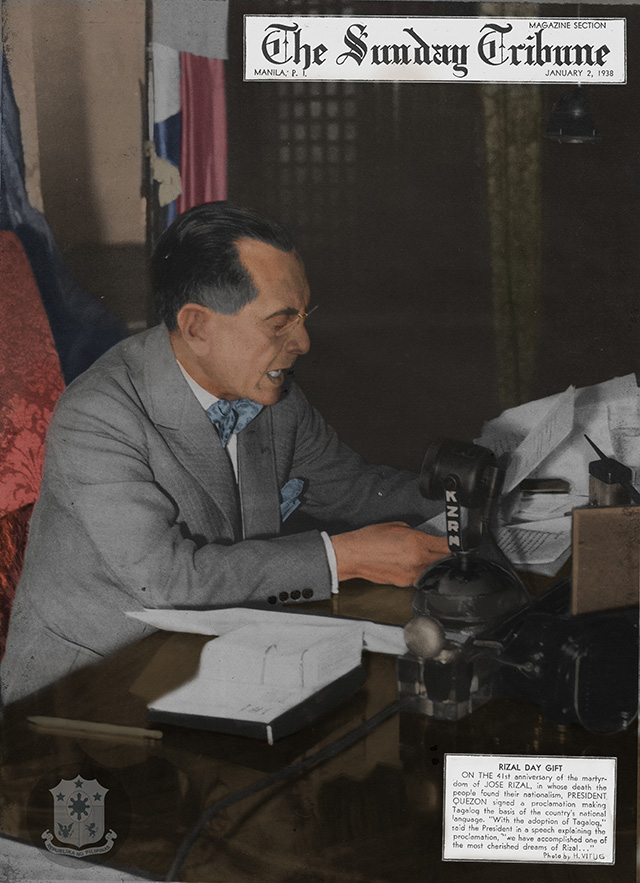
FATHER OF PHILIPPINE NATIONAL LANGUAGE. A colorized version of former president Manuel L. Quezon proclaiming the national language on December 30, 1937. Photo by PCDSPO
MANILA, Philippines - Seventy-five years ago today, President Manuel L. Quezon addressed the nation in Filipino via radio.
It was the first time that a President spoke on air using Filipino, which was declared the Philippines' national language by virtue of Executive Order No. 134 issued on December 30, 1937.
Quezon said in the radio broadcast:
"Nagdudulot sa akin ng di matingkalang kasiyahan na maipahayag ko sa inyo na ngayong ika-41 anibersaryo ng pagmamartir ng nagtatag at pinakadakilang tagapamansag ng nasyonalismong Pilipino, ay naging karangalan kong ilagda, bilang pag-alinsunod sa utos ng Konstitusyon at ng umiiral na batas, ang isang Kautusang Tagapagpaganap na nagtatalaga sa isa sa mga katutubong wika na maging batayan ng wikang pambansa ng bayang Pilipino."
Quezon echoed the recommendation of the National Language Institute (NLI) to adopt Tagalog as the foundation of the national language of the country.
The NLI was mandated to conduct studies on various native tongues with the purpose of evolving and adopting a national language based on one of these dialects.
Explaining the result of their studies, the language experts who comprised the NLI stated in a resolution they passed on November 9, 1937:
"This conclusion represents not only the conviction of the members of the Institute but also the opinion of Filipino scholars and patriots of divergent origin and varied education and tendencies who are unanimously in favor of the selection of Tagalog as the basis of the national language as it has been found to be used and accepted by the greatest number of Filipinos not to mention the categorical views expressed by local newspapers, publications, and individual writers."
The NLI was headed by Jaime de Veyra (Samar-Leyte Visayan) with the following members: Santiago A. Fonacier (Ilocano), Filemon Sotto (Cebu Visayan), Casimero Perfecto (Bicol), Felix S. Salas Rodriguez (Panay Visayan), Hadji Butu (Moro), and Cecilio Lopez (Tagalog).
Advances in use of Filipino
Fast forward to December 30, 2012, the President also addressed the nation in Filipino, but in a Youtube video, reflecting how communication technology has evolved since the declaration of the national language 75 years ago.
In his message, President Benigno Aquino III urged the country to take pride in using the Filipino language as a historical heritage and a medium of unity.
"Paano hahabiin ang pagkakaisa sa kabila ng mga pagkakaiba? Paano pag-aalabin ang malasakit sa kapwa’t sa bandila? Nawa’y maging mas masigasig ang ating pakikisagwan sa iisang direksyon upang maging ganap ang potensyal ng ating Wikang Pambansa," Aquino said.
"Sa liwanag ng katotohanan at katapatang ipinababatid ng ating wika, at ng katangi-tanging pamana ni Rizal, tumitingkad ang ating pagkakaisa, lumalakas ang ating tinig at pagkakapit-bisig tungo sa pag-abot ng ating mga mithiin," Aquino added.
According to communications undersecretary Manuel Quezon III, the present generation of Filipinos has witnessed "advances in the use of the national language," citing the use of Filipino during the State of the Nation Addresses in 2010, 2011, and 2012.
Aquino however said that the challenge to develop the full potential of the language remained. - Rappler.com
Source: http://www.rappler.com/nation/18809-how-filipino-became-the-national-language


